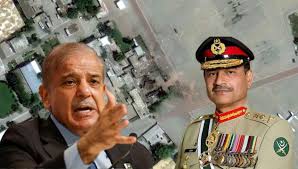Shehbaz Sharif Confirms Indian Missile Strikes on Key Pakistani Military Bases During Operation Sindoor
In a dramatic admission that has sparked a storm of reactions both domestically and internationally, Pakistan’s Prime Minister Shehbaz Sharif has publicly confirmed that Indian ballistic missiles struck multiple Pakistani military installations, including the strategic Nur Khan Airbase in Rawalpindi, during a covert operation named Operation Sindoor.
This unprecedented statement was made during a solemn ‘Youm-e-Tashakur’ (Day of Gratitude) event held at the Pakistan Monument in Islamabad, and clips of his speech have since gone viral across various social media platforms.
Sharif’s remarks mark the first official confirmation from Pakistan’s civilian leadership about the extent of India’s retaliatory strikes, which were reportedly conducted in the early hours of May 10.
In his speech, Prime Minister Sharif described receiving a high-priority secure phone call from the Chief of Army Staff, General Asim Munir, at approximately 2:30 a.m.
“On the intervening night of May 9 and 10, at about 2:30 a.m., I was contacted by General Asim Munir via a secure line,” Sharif recounted.
“He informed me that Indian ballistic missiles had struck the Nur Khan airbase as well as other critical military sites across the country.
I swear to God, there was not a trace of panic in his voice — only confidence, patriotism, and resolve,” he added, clearly emphasizing the military leadership’s composure during the crisis.
Sharif also took the opportunity to praise the Pakistani Air Force (PAF), asserting that it had successfully intercepted some of the attacks using domestically developed defense systems and Chinese-made jets equipped with advanced technology.
“Our air force responded with valor, deploying homegrown systems and utilizing sophisticated technology onboard Chinese aircraft to defend our airspace,” he claimed.
In a more contentious part of his address, the Prime Minister went on to allege that Pakistani forces had successfully downed Indian fighter jets during the operation.
However, this claim has not been acknowledged or verified by Indian authorities, who have thus far maintained strategic silence on specific operational details.
The Nur Khan Airbase, previously known as Chaklala, is one of Pakistan’s most critical military air facilities, situated between the twin cities of Rawalpindi and Islamabad.
Historically significant, it was also a target during the 1971 Indo-Pak war. Alongside Nur Khan, Pakistan claims that two other air bases were hit — Murid Airbase in Chakwal and Rafiqui Airbase in Shorkot (Jhang district).
Further validation of the strikes came from the Pakistan military itself. In a rare pre-dawn press briefing held around 4:00 a.m. on May 10, military spokesperson Lieutenant General Ahmad Sharif Chaudhry addressed the media, confirming that Indian missiles and drones had indeed struck three separate airbases in what was described as a “coordinated and aggressive” maneuver.
The scale of destruction became even clearer when U.S.-based Maxar Technologies released satellite imagery comparing structural layouts from April 25 and May 10.
The images revealed notable damage at four military locations in Pakistan — the Nur Khan Air Base in Rawalpindi, PAF Base Mushaf in Sargodha, Bholari Air Base near Karachi, and PAF Base Shahbaz in Jacobabad.
Analysts examining the visuals pointed to craters, burned hangars, and damaged runways as evidence of precision strikes.
According to defense analysts, India’s deep strikes into the heart of Pakistani military infrastructure stunned many within the global diplomatic and intelligence communities.
The sheer precision and audacity of Operation Sindoor reportedly triggered alarm bells in Western capitals, prompting Washington and other powers to initiate immediate diplomatic interventions to prevent further escalation.
Sources suggest that it was this operation that finally compelled U.S. officials to ramp up back-channel efforts in the region.
Prime Minister Sharif’s acknowledgment has led to swift and sharp reactions from Indian political leaders, many of whom see it as a de facto validation of India’s military capabilities and a diplomatic win. Amit Malviya, the head of the BJP’s IT cell, posted on the social media platform X:
“Pakistan PM Shehbaz Sharif himself admits that General Asim Munir called him at 2:30 a.m. to inform him that India had bombed Nur Khan Air Base and several other locations.
Let that sink in — the Prime Minister was woken up in the middle of the night with news of strikes deep inside Pakistan. This speaks volumes about the scale, precision, and boldness of Operation Sindoor.”
Shiv Sena (UBT) leader Priyanka Chaturvedi was more scathing in her response, stating:
“To be as clueless as this man when terror airbases under his control are being destroyed by India. Deeply satisfying.”
Operation Sindoor, the mission that precipitated these events, was launched by India on May 7 as a direct retaliation for the April 22 terrorist attack in Pahalgam, Jammu & Kashmir, which claimed the lives of 26 Indian civilians and security personnel.
The attack was widely attributed to Pakistan-based terror groups, prompting the Indian government to approve a swift and strategic military response.
While the Indian government has refrained from officially commenting on the operational specifics of Operation Sindoor, Sharif’s disclosure — corroborated by satellite evidence and his military’s statements — paints a vivid picture of a meticulously planned and executed Indian strike.
The revelation also raises critical questions about Pakistan’s air defense preparedness and the extent to which its military was caught off guard.
As regional tensions remain high, Shehbaz Sharif’s candid remarks have not only exposed internal military vulnerabilities but have also ignited a renewed debate on Pakistan’s national security strategy and its approach to handling cross-border terrorism.
For now, all eyes remain on the geopolitical fallout from this incident and the potential recalibration of military doctrines on both sides of the border.

